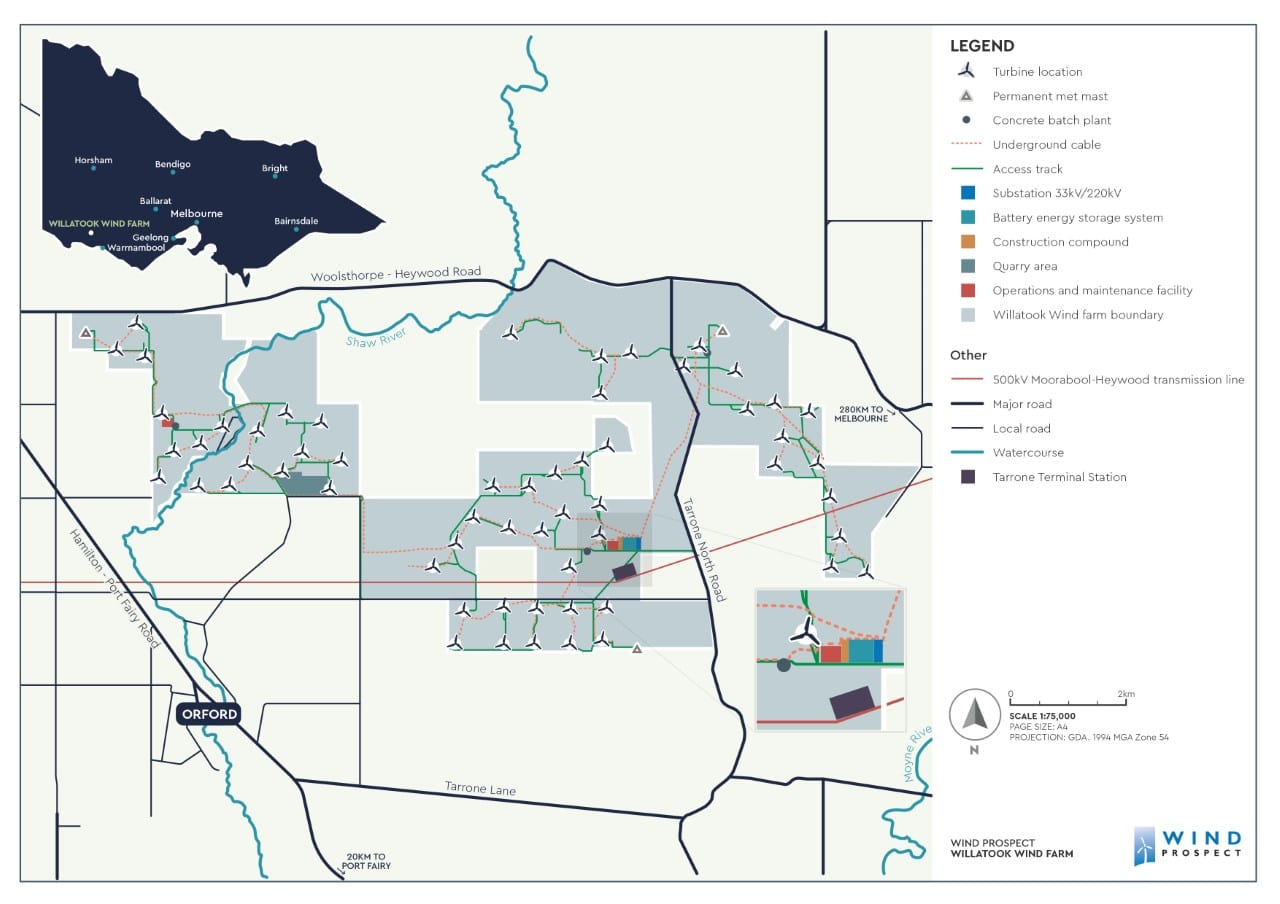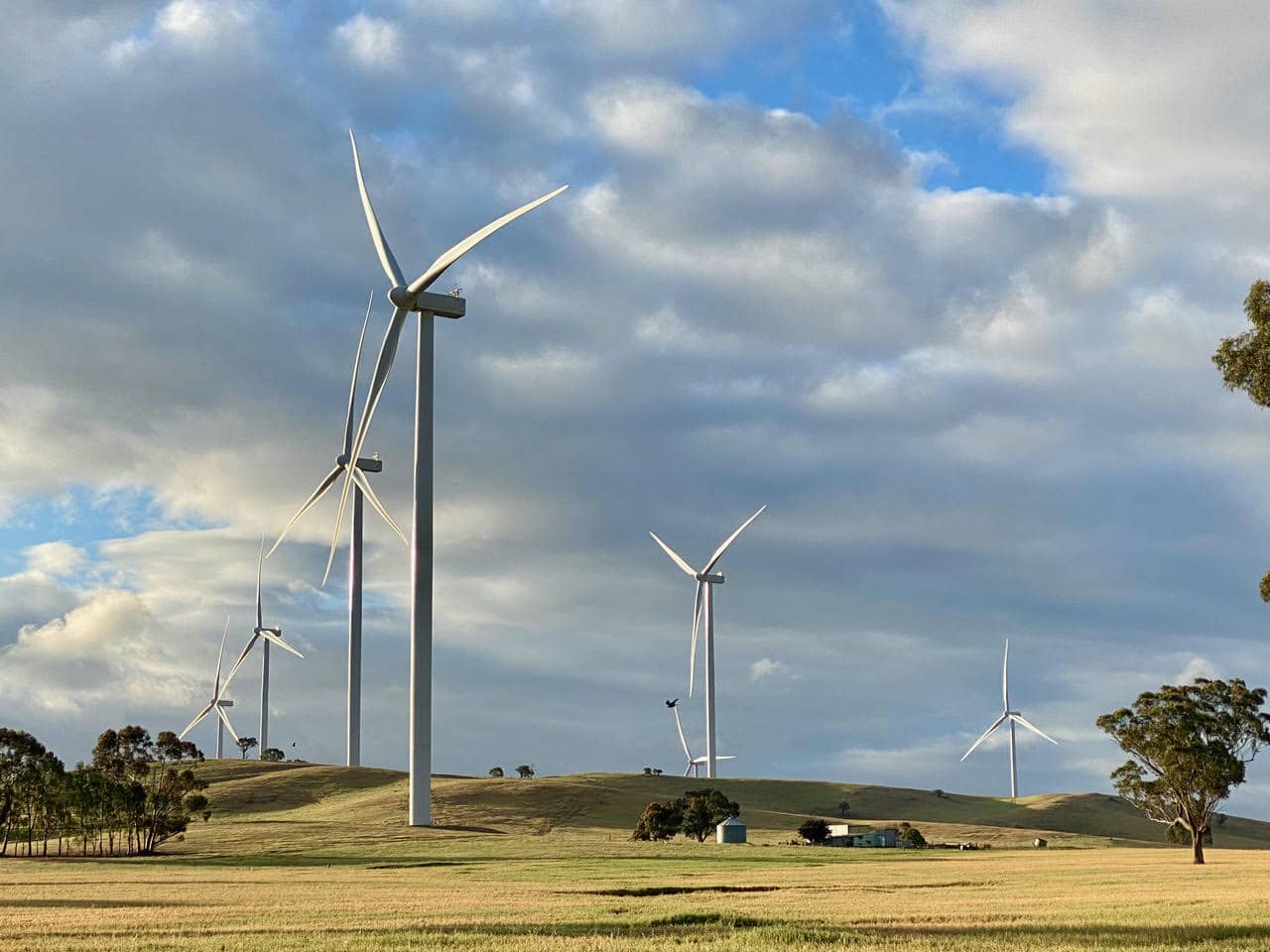The proposed Willatook Wind Farm is located between Orford and Hawkesdale in the Moyne Shire in south-west Victoria.
The Project has been in development since 2010 and is currently progressing through the planning approvals process. If approved, the Project would have the capacity to produce enough clean renewable electricity to power more than 200,000 Victorian homes.
The Project consists of up to 59 wind turbines generators, an on-site battery energy storage system (BESS) and associated infrastructure including a temporary on-site quarry (during construction), access tracks, underground cabling, overhead lines, a substation and transmission powerline located on the Project site to connect to the existing Tarrone Terminal Station.
Location

Map: Current indicative site layout from EES in 2023 (subject to change)
Planning
In Victoria, large-scale wind farms are subject to strict planning controls and environmental regulations under both State and Commonwealth legislation.
Under the Planning and Environment Act 1987, the Minister for Planning is the Responsible Authority for all major energy generation projects, including wind farms. This means the Minister oversees the planning permit process and makes the final decision on whether a project can proceed.
Before a planning permit can be issued for a wind farm, the project must go through a rigorous assessment process. This includes technical studies, public consultation, and formal submission of a planning permit application. These steps are shown in the project development timeline (below).
Following referral to both the Victorian and Commonwealth Governments, the Willatook Wind Farm is being assessed through an Environment Effects Statement (EES) — the highest level of environmental assessment available in Victoria. The EES process has also been accredited under the Commonwealth Environment Protection and Biodiversity Conservation Act 1999, meaning it will serve as the basis for both State and Federal environmental approvals.
While the EES process itself does not grant approval, it provides a comprehensive evaluation of the project’s potential environmental impacts. Once completed, the EES informs the Minister for Planning’s assessment of whether the environmental effects are acceptable. This assessment is then provided to other statutory decision-makers — at the Commonwealth, State, and local levels — who must consider it when deciding on relevant planning and environmental approvals for the project.
Current planning status
In July 2022, the project’s Environment Effects Statement (EES) and planning applications were placed on public exhibition for community and stakeholder feedback. Later that year an Independent Planning Panel was held over four weeks. At the hearing, there were presentations by several expert witnesses, government agencies, Moyne and Glenelg shire councils, and community members.
In mid-2023, the Victorian Minister for Planning released her assessment of the EES. The Minister recommended that the Project could proceed, subject to modifications to address potential impacts on the Brolga and Southern Bent-wing Bat.
Since the release of the Minister’s assessment, we have been investigating ways to modify the Project’s design, construction and operation to secure better biodiversity outcomes while maintaining the viability of the project. We have also awaited further direction from the Victorian Government.
In May 2025, the Victorian Government released new official guidelines to help renewable energy projects manage potential impacts on wildlife, like Brolgas and bats. This new document, called the Handbook for the Development of Renewable Energy in Victoria, provides a clearer and more consistent process for how environmental impacts should be assessed and addressed.
Wind Prospect is in the process of updating a number of technical studies that were originally prepared as part of the EES, responding to the Minister for Planning’s recommendations and the new biodiversity guidelines. This includes revisiting assessments related to species such as the Brolga and Southern Bent-wing Bat.
The overall design of the project will be revised and refined to carefully respond to the Minister for Planning’s recommendations. Part of this process will involve determining the most appropriate planning pathway for making these revisions, to ensure that any updates to the project are released publicly and provide an opportunity for community and stakeholder feedback.
Timeline
Local and regional benefits
The Willatook Wind Farm will bring significant economic and social benefits to the local and regional communities.
Economic benefits
Of the $800 million total cost of the project, an estimated $120 million will be retained in the region including wages, contracts and other services. There will also be benefits to local and regional businesses and service providers, including the hospitality and accommodation sectors, through the provision of services to the construction workforce.
Ongoing economic stimulus in the region is predicted to be $158 million (calculated over 25 years) via financial returns to Moyne Shire, host landowners, neighbour benefit program payments and local wages. This includes rates to the Moyne Shire of about $600,000 each year during the project’s operational life.
Job Creation & Local Procurement:
During construction, local employment opportunities will be created in areas like civil works, electrical installation and turbine assembly. Once operational, the wind farm will provide ongoing jobs in maintenance and operations. Local businesses will also benefit from procurement opportunities in construction, accommodation, catering and transport.
Community Benefit Programs:
Wind Prospect is committed to sharing the benefits of the Project and understands the importance of developing these initiatives in collaboration with the local community.
In 2019 Wind Prospect developed a proposal for a Neighbour Benefit Sharing Program for the Project, to ensure the financial benefits would be shared with those closest to the project. The proposed program has been shaped by feedback from the local community gathered through door knocks, information sessions, our Koroit shopfront and mail outs.
The proposed program will provide:
- Neighbourhood benefits, including support for neighbouring landowners, and businesses.
- Broader community benefits, focused on sharing benefits beyond the immediate area.
Energy Transition:
The project will contribute significantly to the Victorian Renewable Energy Target of 65 per cent by 2030 and provide enough energy to the National Electricity Market to power more than 200,000 homes with renewable energy. Provided the electricity generated by the project replaces electricity generated by brown coal, this will save about 1.3 million tonnes of carbon dioxide each year.
